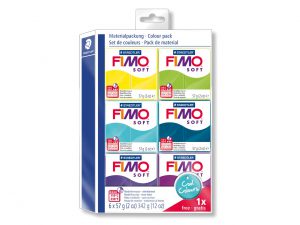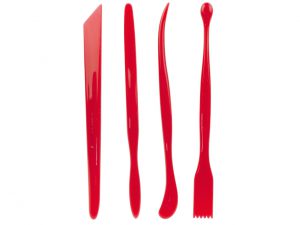Are you just getting started with your new polymer clay hobby? One of the basics you’ll need to learn, in addition to sculpting and modelling, is firing your polymer clay.
We’ve put together our beginner’s guide on how to bake polymer clay, the right way. We’ll cover the perfect baking times and temperatures, useful tips that’ll help you along the way and answer the polymer clay questions we get asked most frequently by our customers.
Read on to learn more.
How long to bake polymer clay for
The baking times and temperatures for baking polymer clay are crucial. If the temperature is too low, the clay will crumble. But if it’s too hot, the outside will fuse and burn before the centre of the clay is cooked through. While baking, the clay should cure evenly throughout and turn into a hard plastic.
Here, at Cooksongold, our polymer clay of choice is FIMO. It was the first modelling clay designed to be fired or baked in a conventional home oven. Naturally, this makes it a really accessible and popular choice for beginners.
Before you start baking your polymer clay, you should always pay attention to the baking instructions on the packaging – other modelling clay brands will have their own specific timings and temperatures.
How long to bake FIMO clay?
| Clay Type | Temperature | Baking Time |
| Fimo Soft | 110 degrees Celsius | 30 minutes |
| Fimo Effect | 110 degrees Celsius | |
| Fimo Professional | 110 degrees Celsius | |
| Fimo Leather Effect | 130 degrees Celsius |
It’s worth noting that timings will vary depending on the width and size of the piece of clay you’re baking – whether it’s a jewellery bead (which you can learn how to make here), charm or decoration.
For more accurate timings, measure the thickness of your polymer clay. So, for example, with a jewellery bead, you would measure the height (top to bottom) as this is the thickest part of the bead.
With a charm, measure the depth (front to back). And with a sculpture, take the measurement of the widest point of the piece on the longitudinal axis. The general rule of thumb is that 6mm is the standard when it comes to baking times.
| Measurement | Baking Time |
| 6mm | 30 minutes |
| 9mm | 45 minutes |
| 12mm | 60 minutes |
Generally, baking for a slightly longer time than required is better than not baking for long enough. If you reach the end of the suggested baking time and you think your piece is still slightly soft, avoid the risk of burning it and remove it from the oven to allow it to cool. Polymer is naturally quite soft when first brought out anyway, so you’ll probably find that it will harden a little more and may need no extra baking time after all. If not, put it back in for a few minutes, but keep an eye on it. In fact, you should never leave your oven unattended when baking polymer clay.
FAQs for baking polymer clay
Here we have answered some of your most frequently asked questions when it comes to baking Fimo clay.
You also need to ensure you bake it for the recommended amount of time, at the recommended temperature to get those very results.
There are air-drying alternatives out there, such as FIMOair Light Clay. These polymer clays simply cure at room temperature – no oven necessary. Once it’s cured, you’re totally free to cut, sand, glue and paint your FIMOair clay as you wish. Shop our FIMO air Light Clay range today.
How many times can you bake polymer clay?

You can bake polymer clay multiple times. It can be handy to bake your clay in stages to avoid causing any damage to what you’ve done previously. Although it is important to note that it will be difficult to attach raw clay to a piece that has already been cured.
It isn’t harmful to bake more than once, although some areas may darken more than others – especially those that are thinner than others, and they may become more brittle.
You cannot, however, rebake polymer that has been painted or glazed.
Can you over bake polymer clay?
Yes, you can over bake your polymer clay. You’ll see the surface darken, and if you burn it, you’ll spot areas of bubbling in addition to those dark patches.
The good news is you can fix your clay if it’s been slightly over baked. Simply cover up the affected areas with another layer before rebaking, or paint over it. Any burnt edges or browned patches can also be sanded off – though this only works if the piece hasn’t been burned all the way through.
We recommend baking a tester piece first, to make sure that you can get it right. Just roll a piece of your clay mixture to the same thickness as your actual piece to get a more accurate representation. Once cool, you will be able to break or cut this sample in half to see if there are any signs of brittleness, or to see if the centre is crumbling.
Can you bake polymer clay in a microwave?

No, microwaves are not advised for baking polymer clay. They don’t heat evenly, and the clay doesn’t react well to a microwave’s radiation. You’ll find some parts of your piece will begin to cure, while others will remain soft.
Can you bake polymer clay in an air fryer?
We don’t recommend baking polymer clay in an air fryer. It’s not listed on the instructions, so until it has been tested by the manufacturer with a definitive result, we’d avoid it. Stick to the oven baking method instead.
Can you bake polymer clay on glass?
We recommend avoiding baking on glass and on metal surfaces. They become too hot, and you run the risk of your piece becoming completely burned.
Instead, we’d advise using a wooden board or a ceramic plate or tile – it’s far better to bake on a surface that maintains a consistent temperature in the oven. This will reduce the risk of over baking or burning.
Top tips for baking Fimo clay:
- Avoid baking on a metal or glass surface – use a wooden board or a ceramic plate or tile.
- When baking beads, hang or prop them up so they don’t touch any surface to avoid gaining a flat side on your bead.
- Avoid breathing in the fumes when baking polymer clay. If you’re not working in a well-ventilated area then consider wearing a dust mask.
- If you have used any kitchen equipment when baking Fimo, do not use it for food preparation in the future. Using the right polymer clay tools will help you to avoid these contamination issues.
- When baking in a conventional oven, after reaching the correct level of heat, the temperature may spike or alter as you open the door to put your piece in to bake. To help avoid this, place a couple of ceramic tiles inside the oven – these will act as a heat sink to help stabilise the oven temperature.
Once you’re finished baking polymer clay, you can decorate your piece as you wish – using paints or other finishes to create beautifully unique designs.
Now you know how to bake polymer clay, you can get started on bringing your designs to life.
Don’t know where to start? Discover our full range of FIMO polymer clays and clay tools for everything you’ll need to kickstart your new hobby.

Cooksongold
